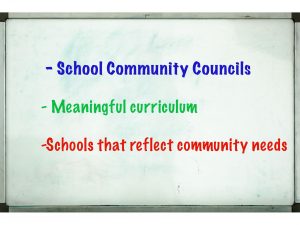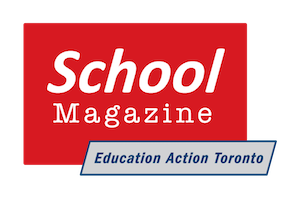There is no de-streaming without democracy and meaning
For the past year and a half School Magazine has concentrated on Doug Ford and the destruction brought about by his government, on social services health, cities, transit, the environment, the legal system and – let’s not forget – education. We’ve spent most of our time writing about what schools and kids have lost or are about to lose.
This isn’t going to change, but it’s still important to look at some of the serious issues in schools that affected them well before Doug Ford and his followers decided to take a blunt axe to education in Ontario.
Here is one such serious issue – streaming. For many generations, students across the province have been streamed into programs according to their perceived abilities, differences or suitability for a prescribed level of education.
Two years ago, our much-missed George Martell wrote an article about the latest attempt by the Toronto District School Board to address the inequities railed against for decades by parents, education activists and teachers. This came out in the form of The Enhancing Equity Task Force Report. One of its recommendations was to remove streaming from schools for students in grades 9 and 10. All students would take part in the most academic program. Less academic programs would disappear.
George wrote the following critique as an open letter to the authors of the report.
Dear Friends,
As always, I appreciate and admire your concern for the “systemic barriers faced by students from historically and currently marginalized groups” as well as your consistent and diligent work in bringing the research on these barriers into the public arena. But I have a real worry that the present neo-liberal re-structuring of Ontario schools – even when incorporating a seemingly “progressive” de-streaming agenda – will make your current focus on dismantling the TDSB streaming system largely irrelevant. It may also provide cover for a more deeply embedded, though less obvious, streaming structure for poor and racialized students.
The recent Enhancing Equity Task Force Report by the administration of the Toronto District School Board gives us some sense of what this “progressive” neo-liberal de-streaming looks like on the surface. Its recommendations include integrating more special-education students into the regular classroom, phasing out applied-level courses for Grade 9 and 10 students in favour of academic courses that keep post-secondary options open. That doesn’t sound so bad. What these recommendations will come down to in practice, however, is another story.
My worry about officially implemented de-streaming stems from my understanding that the assumptions of anti-streaming organizing in Toronto during the 1960s and 1970s, even into the 1980s, are no longer all that relevant to the present day.
We assumed in those earlier years that bringing the streaming issue to poor and racialized communities would stir significant protest and widespread demands for significant structural and curriculum reform. To some extent it did that, though the gains of those years have largely been obliterated. The growth of authoritarian neo-liberalism in our schools has substantially degraded the educational experience of poor and racialized students We have watched growing austerity, a thorough assault on local school and board democracy, and a profound hardening of the social and administrative hierarchy in our schools.
In those early years the level of this assault on public schooling was not evident. We were optimistic that an anti-streaming campaign could have some clout and result in genuine reforms. That optimism rested on three arguments:
 First, streaming (especially bottom-streaming) was where the oppression of subordinate-class kids was most obvious; it was where the rubber of a stratified school system hit the road. Poor and racialized parents could see it clearly and wanted to deal with it. De-streaming seemed to offer clear alternatives. At the same time, these parents had available to them quite a substantial community involvement/community control movement, though which their concerns could be mobilized. At one point, this movement even had an institutional arm at the old Toronto Board of Education in the School Community Relations department, which hired progressive organizers to work alongside and largely under the control of local school communities.
First, streaming (especially bottom-streaming) was where the oppression of subordinate-class kids was most obvious; it was where the rubber of a stratified school system hit the road. Poor and racialized parents could see it clearly and wanted to deal with it. De-streaming seemed to offer clear alternatives. At the same time, these parents had available to them quite a substantial community involvement/community control movement, though which their concerns could be mobilized. At one point, this movement even had an institutional arm at the old Toronto Board of Education in the School Community Relations department, which hired progressive organizers to work alongside and largely under the control of local school communities.
Second, the de-streaming campaign was often led by engaged elementary classroom teachers, many of whom had worked out solid Whole Language programs (incorporating a thoughtful approach to phonics as well as serious social justice dimensions to their curriculum). While these programs did not have an overarching political perspective, they were nevertheless effective in significantly improving literacy and student engagement. These teachers were rightly proud of their work and could look their students and parents in the eye. They knew they were already making a difference for the children they taught and that de-streaming would assist in their developing good programs for a wider range of kids. Furthermore, in the elementary schools in the old city of Toronto, these teachers were backed by their union, which supported strong teaching and a strong community outreach.
Over the last forty or fifty years, these three assumptions no longer hold the ground they once did.
The loss of school-community councils
First, while parent anger at streaming, especially bottom-streaming, is still very much alive, it now rises up only sporadically in isolated sectors of the present system. This is largely the result of a systematic Ministry and local board bureaucratic assault on what we used to call “School-Community Councils,” which involved solid teacher and parent participation to mobilize people city-wide.
In response to the potential of this growing local-school power, provincial legislation turned these councils into toothless shells, especially in poor and racialized neighbourhoods. They are now called “School Councils.” They are overwhelmingly run by local principals. Teacher participation is not encouraged and only one teacher per council is officially required. Substantial policy issues are very rarely raised, if at all. Unsurprisingly, these councils are also sparsely attended by – a comforting outcome for the current administration.
Teachers’ pride in their work
Second, a great many of our teachers are no longer in a position to be proud of their programs. A provincial regime of Outcomes Based Education, Standardized Testing and vast, exhausting administrative/accounting responsibilities have largely crushed any classroom teacher curriculum reform movement in the public schools. As a result, serious de-streaming doesn’t have the sense of purpose it once had for many teachers.

Bottom streaming helps get rid of resistant students, increasingly alienated from the official curriculum. Teachers are equally alienated from this curriculum, and many find themselves going through the motions of teaching to keep their kids in line. It’s hard to generate enthusiasm for a program you don’t believe in and your students dislike. So, for a good many teachers it’s easier to just let the resisters slip away to the bottom streams, and do what you can for the ones who are left.
Teachers alone, are not in a strong position to fight for curriculum reform in their local area, and so far, their union has not taken up this struggle.
Warehousing students
The third change is that the provincial government is now moving ahead with an intensified warehousing program for poor and racialized students, which doesn’t require the old expensive structures of elementary special education and secondary bottom streams. It will carry this out by destreaming schools.
Claiming that it is doing away with streaming gives the Ministry much more leverage in fending off criticisms of the social-class and racial hierarchy of our schools. Ministry officials can present themselves as progressive reformers in this territory, so long as the reality of their reforms remains under wraps. Their hierarchical structure is no longer so vulnerable to attack and to change as it once was.
My impression is that this warehousing being set up by expanding the current de-streaming will only be supported through your committee’s recommendations to introduce destreaming in grades 9 and 10 without additional recommendations focused on substantial curriculum and democratic reform.
Destreaming as it now stands will shovel students, who are struggling and giving their schools a hard time into the regular classroom. It’s an intensification of the process your report notes in which “students from the lowest income tertile were overrepresented amongst those placed in the regular classroom but given Individual Education Plans (IEPs) without formal identification of exceptionalities.”[1]
At the same time, we are watching the move away from EQAO’s system-wide standardized testing to more random testing. That should be a good thing, though even random testing itself is destructive and distracts from authentic classroom work. But “de-testing,” like “de-streaming,” makes the warehousing process easier to implement. Downward patterns in standardized test scores in poor and racialized schools will no longer make the front pages of our local newspapers. Official and non-official reform conversations can slide off the agenda.

As in American inner cities, these student warehouses will become officially invisible in the public realm – a dark marginalized territory, to be explored by an occasional investigative journalist, and to be named by outraged parents and teachers only at moments of school crisis.
The result of this warehousing will be a significant decrease in what is actually learned in these classrooms, particularly because of increased exhaustion and stress on the regular classroom teacher, already exhausted and stressed by current regulations and the powerlessness they engender. Filling out IEPs is enormously time-consuming, worthless for future planning and largely destructive because of the new pressures on the classroom teacher to pay attention to the reduced “expectations” embedded in IEPs. Adding to teacher burnout, will be the system’s slow-but-sure reduction in support for these classrooms. Paid services like tutoring in wealthier neighbourhoods will heighten as those without the means wring their hands over the inequities involved.
With random testing, the Ministry and board swat teams policing standardized test scores in poor and racialized neighbourhoods can back off; so you can bet that what little support they do bring by way of extra resources will also be discontinued. As in large American cities, our schools in poor and racialized neighbourhoods will be left to hang in the wind, increasingly violent, uneducated school-to-prison pathways.
It’s important to recognize that for Ontario’s governing class in education and for the corporations they represent, this intensification of warehousing makes sense. As an overwhelming amount of research now tells us, in the not-to-distant future there will be a massive reduction in the jobs (full-time, part-time and precarious) that will be available for students in poor and racialized neighbourhoods. In one way or another, this reality of global capitalism trickles down into the bureaucracy and staff of our poorest public schools.
Here the judgment grows that the students in these schools have to be written off – as workers, as citizens, as consumers. They don’t need an education of any sort. We can expect nothing of them as adults. It is a view, by the way, that has led to much official thinking about a “basic income” for everyone, which will also mean, as many analysts have pointed out, a significant decrease in social wages – in education, health, social services, etc. Neoliberal austerity isn’t going away.
Overall, our educational governing class has largely stopped worrying about “socializing” poor and racialized kids for the current social order, as they did four or five decades ago. Now there is a growing tendency to rely on the police, the courts, and the prison system, much as this governing class did a century or two ago, though much more explicitly. Both perspectives, of course, run against the grain of what good teachers know is important: an engaging and purposeful curriculum and an opportunity to become thoughtful and active citizens. It’s hard to say, however, how much of an impact even these good teachers now have in the current neoliberal context of our schools.
Schools and the production of “human capital”
This “warehousing” response of our educational governing class to capitalism’s current needs has a long history behind it. As Queen’s Park designed the public-school system in the mid 19th century, it was largely meant for rural and working-class children to learn to be docile and energetic workers in the new industrialized Ontario school bureaucrats figured was just around the corner. It was education for working-class “human capital” production.
 Middle-class participation, on the other hand, was not expected, but this class moved into public schooling anyway because they couldn’t afford private school fees. Current school policies, it’s worth noting, still press the middle class to bail out of the public system, and if current policies gutting curriculum come to fruition we may yet see a large middle-class retreat from their neighbourhood schools, whatever the cost.
Middle-class participation, on the other hand, was not expected, but this class moved into public schooling anyway because they couldn’t afford private school fees. Current school policies, it’s worth noting, still press the middle class to bail out of the public system, and if current policies gutting curriculum come to fruition we may yet see a large middle-class retreat from their neighbourhood schools, whatever the cost.
The founder of Ontario schools, Egerton Ryerson, would entirely approve of such initiatives; he’d realize the standardization agenda he’d put into action in the mid 1800s was alive and well and working to hold the critics of “human capital” production at bay. The children of the poor, he would understand, would still be retaining their proper and accustomed place at the bottom of the social order.
The “human capital” thrust of our schools for the working class (especially in poor and racialized neighbourhoods) has largely been hidden by a thick rhetoric of what might be described as “official progressivism.” This rhetoric, repeated over and over again throughout almost two-hundred years, insisted that Ontario’s schools were concerned with the happiness and well-being of our children, despite a completely different reality.
On the ground of classroom practice, Queen’s Park continuously promoted fragmentation of student consciousness, breaking up their awareness of themselves in their communities and families with all their idiosyncrasies. This fragmentation was reflected in standardized curriculum, school readers, tests, pedagogy, etc. What our “school promoters” at Queen’s Park learned early on was that, while they couldn’t get working-class or rural children to happily sing the company song (at work, in political life, in religion), they could make it very difficult for them to find their own song to sing. Fragmentation of consciousness of themselves and their learning was essential to this end. It made working-class and rural children vulnerable to becoming human capital on the job as citizens, as consumers. They had less of their own story, history, practice of resistance to call on.
That approach, Ministry bureaucrats recognized, would yield substantial results. The last thing they ever wanted were genuine forms of effective work and learning or an informed citizenry. Ministry practice was never meant to transmit knowledge and stimulate learning. The standardization of curriculum and pedagogy from the mid-19th century to the present has made that abundantly clear.
Parents, teachers, communities, however, often fought back – sometimes with a fair amount of success, in part because it took industrial capitalism longer to establish its power than our ruling and governing classes had originally imagined. But, slowly over the years, these subordinate-class constituencies lost ground, until we have now reached our present set of circumstances: the damaged lives of so many children (especially in Indigenous and poor working-class and racialized communities); the growing assault on their classroom teachers, as work load and stress levels make solid teaching almost impossible; and the abandonment of thousands of poor and racialized students to warehousing in regular classrooms.
Preparing kids for reduced expectations
What we are watching is a school system that is no longer simply in the business of reproducing workers and citizens for a hardening global capitalism. It has now engaged in reducing the expectations of that part of its working-class/racialized population which can no longer be expected to work or even to aspire to minimum citizenship.
This new role is what warehousing is about. It adds to the growing authoritarian framework of neoliberal schooling, embodied in mounting austerity, the gutting of education democracy and an official classroom experience hurtful to both teachers and students: increased standardization of curriculum and testing, destructive behavioural profiling and a deepening social-class and racialized streaming system.
Under our current circumstances of provincial control, a board, like the TDSB, has little power to remedy this situation. Reform advocates within the board can, however, reach out to parents, teachers, poor and racialized communities with strong recommendations for a broad and powerful agenda of change.
Quality schooling for all students
At the centre of this agenda, I would argue, is the issue of quality schooling, defined explicitly in terms of what Mi’gmaq writer, Marie Battiste, has termed the “nourishment of the learning spirit” in our children. This is an agenda that brings together Indigenous and subordinate-class communities and teachers. It abandons Outcomes Based Education and standardized testing and, in their place, insists on a curriculum that asks our students to think about and express their deepest thoughts and feelings and to figure out, with their teachers, what’s to be loved in the world and what’s to be changed.
 It is a program that incorporates an understanding of “words of power” that touch the hearts and minds of children, words that come from the inside out, rather than imposed through standardized curricula. At the same time, such a reform agenda must also reflect a fundamental human need to reach out, in increasingly widening circles, to the larger community. It means being consciously part of the larger human story of building “home” here on earth, what writer John Berger once called “the heart of the real.” It’s a human identity even our youngest students can readily grasp.
It is a program that incorporates an understanding of “words of power” that touch the hearts and minds of children, words that come from the inside out, rather than imposed through standardized curricula. At the same time, such a reform agenda must also reflect a fundamental human need to reach out, in increasingly widening circles, to the larger community. It means being consciously part of the larger human story of building “home” here on earth, what writer John Berger once called “the heart of the real.” It’s a human identity even our youngest students can readily grasp.
Finally, it’s essential that we substantially increase the democracy of our local schools. We have to recover and add to the power of school councils, recognizing again that they are “School-Community Councils” and must be a fundamental democratic force in our school system. We also have to bring in-school decision-making power down into the hands of our teachers and students, so teachers can effectively respond to their students’ circumstances and their own needs as teachers. Students can learn genuine citizenship in helping with the development of their curriculum and in the way their school is run. Nowhere is this local democracy more important than in having teacher-parent power in determining what to do about those relatively few students who have been seriously hurt intellectually and emotionally, who are often destructive of solid classroom learning for all, and who are most likely to be placed in oppressive bottom streams. Local schools must have the option of thinking these programs and approaches through, adding their own solutions, and implementing the options they think hold the most promise and which they can change as their experience grows.
So, by all means, keep the “de-streaming” (and linked “de-profiling”) pressure on, but, at the same time, maintain a focus on meaningful curriculum and local democracy. If you will forgive the rhymed couplet: “There is no de-streaming/without democracy and meaning.”
In solidarity,
George Martell
This article was edited for length.

